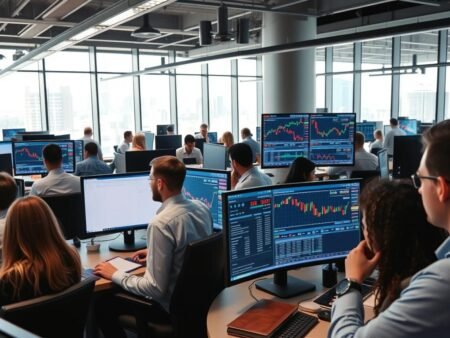In the world of proprietary trading, every choice can lead to big wins or huge losses. What makes some firms last while others fail? It’s their strong focus on prop trading risk management. This is what keeps them stable and growing.
Prop firms navigate risky waters with skilled traders at the wheel. They use top-notch risk control techniques for prop firms to protect against daily market ups and downs.
Prop firms are unique because they control their own destiny. They focus on protecting trader capital in proprietary trading above all. They mix bold trading with careful risk management. This is a delicate art that, when done right, is the key to their success.
This article will show how prop firms stay ahead. We’ll look at how they adapt their risk strategies and keep their capital safe from trading’s unknowns.
Key Takeaways
- The importance of risk management for prop firm stability.
- Why effective risk control is crucial for both trader capital and firm longevity.
- The need for prop firms to find a balance between bold trading and caution.
- An in-depth look at how prop firms evolve their risk strategies to stay financially secure.
- Insights into how prop firms handle the uncertainties of proprietary trading.
Understanding the Proprietary Trading Landscape
Proprietary trading, or prop trading, is when firms trade with their own money, not clients’. This is different from how banks usually trade. It’s key to the market’s liquidity and efficiency. But, it also brings big risks to these firms.
Knowing how prop trading works is key to understanding the proprietary trading risk strategies firms use to avoid big losses.
The Basics of Prop Trading
Prop trading lets firms fully use market chances without client limits. They use data, market analysis, and trader skills to guess market trends. The profits can be high, but so are the risks, making trader loss mitigation in proprietary trading crucial.
Why Risk Management is Crucial for Prop Firms
Trading markets are volatile, offering big rewards but also big risks. That’s why risk management is vital, not just a part of a firm’s plan but its core.
| Risk Factor | Impact on Prop Firm | Mitigation Strategy |
|---|---|---|
| Market Volatility | High potential for rapid financial loss | Dynamic hedging and real-time analytics |
| Leverage Usage | Can amplify losses | Strict leverage guidelines and continuous monitoring |
| Regulatory Changes | Potential for compliance failures | Regular legal reviews and compliance training |
It’s important to know how leverage, market changes, and rules affect trading. Without good risk management, even the best trading plans can lead to big financial problems for firms.
Risk Control Techniques for Prop Firms
In the world of proprietary trading, it’s crucial to have good risk management measures for prop trading desks and follow prop firm risk management policies. Prop firms use advanced strategies and tools to protect themselves from market shocks. This helps them grow steadily. We’ll look at key techniques for managing trading risks.
Real-time risk monitoring is a key method. It lets firms watch trader activities and positions all the time. This helps spot and stop risks before they cause big losses.
Focused and vigilant monitoring forms the backbone of effective proprietary trading risk management.
- Leveraging real-time analytics to track market conditions and trader compliance with firm policies.
- Position size limitations to ensure that no single trade can significantly impact the firm’s financial health.
- Customized risk parameters tailored specifically for each trader, depending on their experience and past performance records.
These measures help create a strong risk management system. It can quickly adjust to market and operational changes.
| Risk Control Technique | Objective | Implementation Method |
|---|---|---|
| Real-Time Risk Monitoring | Continuous oversight of trading activities | Deploy advanced software tools and platforms to track live data |
| Position Size Limits | Minimize potential losses per trade | Set maximum allowable trade size based on total capital |
| Customized Risk Parameters | Personalized risk management | Adjust risk levels based on individual trader performance and risk tolerance |
Using these risk management measures for prop trading desks helps firms meet regulatory standards and achieve their goals. It’s about keeping the firm’s capital and reputation safe while aiming for profits.
Trader Loss Mitigation in Proprietary Trading
In the fast-paced world of proprietary trading, risk management is key to success. This section explores strategies for reducing trader losses. We focus on daily loss limits and stop-loss orders, vital for prop trading loss prevention and risk management measures for prop trading desks.
Daily Loss Limits for Traders
Daily loss limits are a proactive risk management strategy. They cap the maximum loss a trader can face in one day. This helps prevent a bad day from turning into a financial disaster.
By setting these limits, prop trading desks protect both the trader and the firm from big losses. This limits exposure to market risks.
Implementing Stop-Loss Orders
Stop-loss orders are crucial for prop trading loss prevention. They protect gains and limit losses by selling automatically when a price is hit. These orders help keep capital safe and promote disciplined trading.
They remove emotional decisions from trading. This leads to better, more informed trading.
To show how these measures work in daily trading, here’s a comparison:
| Feature | Daily Loss Limits | Stop-Loss Orders |
|---|---|---|
| Objective | Cap losses to prevent large downturns | Secure profits or minimize losses by automating sell-offs |
| Benefits | Reduces financial risk and promotes conservative trading | Enhances risk management by setting automated exits |
| Implementation | Set based on individual trader performance and market conditions | Positioned at strategic price points to limit potential downside |
| Impact on Trading Behavior | Encourages more calculated risk-taking | Promotes discipline and reduces emotional trades |
By using these risk management measures for prop trading desks, firms protect themselves. They also create a safe space for traders to make informed decisions. These decisions support both personal and company financial goals.
Prop Trading Risk Management Policies
In the world of proprietary trading, prop firm risk management policies are vital. They are the foundation of strategies to protect trader capital in proprietary trading. Prop firms use these policies to keep their operations safe and manage risks well.
One important part of these policies is setting limits on leverage. This means traders can’t use too much borrowed money. It helps the firm and traders avoid big risks. Also, policies on diversification spread out risks, making trading safer.
- Leverage caps to manage exposure
- Mandatory risk management training for traders
- Regular audits and compliance checks
- Risk diversification protocols
Training programs for traders are a must. They teach the latest in risk management. This training shows how important it is to follow rules and keep trading safe.
| Policy | Purpose | Benefit |
|---|---|---|
| Leverage Limits | Control over-exposure per trade | Reduces potential for significant losses |
| Diversification Requirements | Spread risk across various assets | Protects against market volatility |
| Continuous Training | Enhance risk management skills | Greater compliance and safer trading practices |
These policies help keep trading safe. They show how important strict rules are for protecting trader capital in proprietary trading. By following these rules, prop firms stay in line with standards and build a strong reputation.
Utilizing Proprietary Trading Risk Strategies
Effective risk management is key for proprietary trading firms to thrive. This section explores the proprietary trading risk strategies firms use. These strategies help manage risks and protect their operations.
Quantitative Risk Management Methods
Quantitative models are crucial for prop trading desks. They use Value at Risk (VaR) and key risk indicators (KRIs) to predict risks. These tools help estimate potential losses within a certain confidence level.
By quantifying risk, prop trading desks can handle market volatility better. They ensure their exposure stays within safe limits.
Stress Testing and Scenario Analysis
Stress testing and scenario analysis are vital in proprietary trading risk strategies. These methods test how well trading strategies perform under tough market conditions. Stress tests and scenario analyses are essential for strong risk management.
These quantitative assessments help prop trading desks manage risks effectively. They tailor risk management measures for prop trading desks to prevent and reduce threats.

Protecting Trader Capital in Proprietary Trading
In the world of proprietary trading, protecting trader capital is crucial for a firm’s success. Prop firms use detailed prop firm risk management policies to keep these assets safe. This section looks at how to keep trader capital safe.
Key steps include:
- Segregation of client accounts to keep trader funds separate from operational costs.
- Strict rules on capital allocation to avoid too much risk.
- A strong financial buffer to handle unexpected trading losses.
These steps not only protect trader capital but also build trust. This is key in a high-stress field. By being open and accountable, prop firms can lower financial risks and improve trading results.
“The strength of our risk management policies is linked to the stability of trader capital. Every step we take is to increase confidence among our traders and clients.”
Also, the table below shows how good risk management helps keep trader capital safe:
| Strategy | Objective | Outcome |
|---|---|---|
| Segregation of accounts | Keep client funds safe from firm use | More secure trader investments |
| Capital allocation rules | Control risk in trades | Fewer big losses |
| Financial buffer | Cushion against market shocks | Stability in tough times |
Good prop firm risk management policies are key to keeping trader capital safe. By using these steps, trading firms protect their traders and set themselves up for long-term success.
Robust Training Programs for Risk Awareness
Proprietary trading firms are now focusing more on risk control techniques for prop firms. They do this by creating strong training programs. These programs help build a culture that is aware of risks. They are key in teaching traders how to avoid losses, helping the firm stay safe from market surprises.
Developing a Risk-Conscious Culture
Prop firms understand the trading world is complex. They aim to make risk control a top priority. They teach traders about financial risks and how to stay safe. Through training, traders learn to handle market challenges well.
Workshops and Continuous Learning Opportunities
Workshops and seminars are crucial for keeping trading teams up-to-date. They cover the latest in risk management and market trends. These sessions mix practical skills with theory, helping traders use risk control techniques for prop firms in real situations.
- Focused workshops on scenario analysis and risk response strategies.
- Seminars featuring industry experts discussing case studies on trader loss mitigation in proprietary trading.
- Regular updates and refreshers on evolving market conditions and risk assessment tools.
By offering ongoing education, firms make their traders more ready. This readiness helps the firm stay strong in both operations and finances.
Ensuring Capital Preservation through Tech Solutions
In the world of proprietary trading, technology is key to success. It’s especially important for prop trading risk management. Prop firms use advanced monitoring software and real-time risk platforms to protect their money, even when markets are unpredictable.
Advanced Monitoring Softwares
Advanced monitoring software is a big part of prop trading risk management. It lets fund managers watch traders and their positions closely. This gives a detailed look at the risk on the trading floor.
The software’s smart algorithms spot unusual trading or high risks. This helps managers take action fast to fix problems.
Real-Time Risk Management Platforms
Real-time risk management platforms work with monitoring software to handle market changes quickly. They help firms act fast to protect their money. These platforms use the latest tech for constant watch and risk checks.
This means they can report risks quickly and help make better decisions, even in stressful times.
| Feature | Advanced Monitoring Software | Real-Time Risk Management Platform |
|---|---|---|
| Core Function | Tracks and analyzes trader actions and market positions | Provides immediate responses to market changes |
| Key Benefit | Identifies and alerts on risks proactively | Decreases response time to market fluctuations |
| Target User | Risk managers and compliance officers | Traders and risk management teams |
Prop trading is complex and needs both smart planning and tech. Using the latest in real-time risk management platforms and advanced monitoring software helps keep money safe. This is the key to lasting success in prop trading.
Risk Management Measures for Prop Trading Desks
Effective prop trading risk management is key for keeping trading firms stable and profitable. A good risk control plan includes strict rules and flexible strategies. This helps both traders and management make better decisions together. We’ll look at how teamwork and risk managers help prop firms succeed.
Collaborative Approach in Risk Decision-Making
In proprietary trading, sharing ideas and planning together is crucial. Traders, risk managers, and others work together to understand risks and market conditions. This teamwork helps spot risks early and share the work of reducing them.
Having different views helps trading desks quickly adjust to market changes. This makes the firm better at protecting itself from sudden market shifts. Such teamwork not only makes risk management more effective but also builds trust and responsibility within the firm.
Role of Risk Managers in Prop Firms
Risk managers are vital for a trading firm’s success. They make sure all trading fits within the firm’s risk limits and follows rules. They set risk limits, check market risks, and teach traders about risk policies.
Risk managers also create plans to reduce risks and enforce them. They watch over trading closely and keep improving. Their work helps cut down losses and keeps the firm stable and profitable.
This organized way of managing risks at both individual and team levels protects against big financial losses. It also helps proprietary trading firms stay strong and successful in a competitive market.
How Prop Firms Protect Themselves Against Trader Losses
Proprietary trading firms know the risks of trading markets well. They use smart strategies and strict rules to stay safe from financial ups and downs. This part talks about how firms manage risks, using tech, training staff, and strict trading rules.
A strong risk-aware culture is key to avoiding trader losses. It’s not just about rules; it’s about teaching caution and awareness. This way, traders know the risks and how to handle them.
Technology is crucial in how prop firms protect themselves against trader losses. It gives traders real-time data to make quick, smart choices. This tech is vital in today’s fast trading world.
Strong prop trading risk management policies are also vital. These rules set limits for traders, keeping the firm safe. Regular checks and updates of these rules help the firm stay ahead in changing markets.

| Risk Management Strategy | Description | Impact |
|---|---|---|
| Daily Loss Limits | Set maximum loss a trader can incur in a day. | Prevents significant one-day losses that can destabilize the firm. |
| Continuous Training | Ongoing educational programs on risk strategies. | Enhances trader skills and awareness, leading to better risk decisions. |
| Technology Integration | Use of advanced analytics and real-time systems. | Identifies potential risks quickly, allowing for immediate corrective action. |
In conclusion, prop trading risk management uses many strategies. It combines culture, tech, and rules to avoid losses. Each part is important for a safe trading place. With good management, training, and tech, firms stay ahead in trading.
Leveraging Asset Diversification to Minimize Risks
In proprietary trading, protecting trader capital is key to success. Many prop firms use asset diversification to do this. This method helps avoid big losses and is vital for managing risks.
By investing in different types of assets and markets, prop firms can lessen the impact of a downturn. This is especially true for a single sector.
Diversification is a top risk control technique for prop firms. But, it must be planned carefully. Each firm has its own risk profile to consider.
- Variety of Assets: Includes stocks, bonds, commodities, and even cryptocurrencies to spread risk.
- Geographical Spread: Investing in markets across different regions to hedge against localized economic downturns.
- Sector Dispersion: Allocating capital to different industry sectors, from technology to healthcare, ensures that a hit in one sector does not impact the overall portfolio heavily.
While diversification offers many benefits, it also has challenges. For example, it can dilute the potential for high returns from a focused investment. Also, managing a diverse portfolio can increase costs, affecting profits.
| Asset Type | Benefits | Risks |
|---|---|---|
| Equities | Variability in options, potential for high returns | Market volatility, economic impacts |
| Fixed Income | Stability, consistent income | Interest rate risk, lower returns |
| Commodities | Hedge against inflation, diversification | Commodity price volatility, geopolitical issues |
| Cryptocurrencies | High potential returns, emerging market | Regulatory risks, extreme volatility |
When done right, diversification in proprietary trading helps protect capital and strengthens risk control techniques. A well-thought-out diversification strategy takes into account the firm’s risk tolerance and goals. This approach maximizes returns while minimizing risks from any single event or market downturn.
Prop Firm Risk Management Policies: A Strategic Overview
Proprietary trading firms around the world have strict prop firm risk management policies. These policies protect their assets and the money of their traders. They set clear trading limits and use detailed risk assessments to lower financial losses. This part talks about setting risk limits and evaluating risk-to-reward ratios, key for keeping profits up and growing in prop trading.
Setting Comprehensive Risk Limits
Good risk management for prop trading desks begins with setting broad risk limits. These limits match the firm’s unique strategies and money plans. They make sure each trader stays within a safe money range. This helps control big losses and risky bets that could harm the firm’s money health.
Risk to Reward Evaluations
Another key part of prop firm risk management policies is doing detailed risk-to-reward checks. This means looking at trades to guess their results, balancing expected gains against risks. By doing this, traders and firms can make smart choices that increase earnings and cut losses.
| Factor | Consideration in Risk Limit Setting | Importance in Risk-to-Reward Evaluation |
|---|---|---|
| Capital Allocation | Amount allocated must not exceed specific percentages of total capital. | Essential for determining viable trade sizes and potential growth. |
| Market Volatility | Adjust limits based on current and forecasted market conditions. | Critical for assessing the feasibility of projected profits vs. losses. |
| Historical Performance | Review to set thresholds that prevent past mistakes. | Used to gauge expected trade success rates based on past results. |
In summary, having clear prop firm risk management policies is vital for the health and success of proprietary trading desks. With the right risk management and policies, prop firms can improve their work and profits, leading to long-term success.
Strategic Position Sizing in Prop Trading
In the world of proprietary trading, prop trading risk management and trader loss mitigation in proprietary trading are key. They help keep profits up and capital safe. Strategic position sizing is crucial, affecting trade outcomes and firm risk.
Position sizing in proprietary trading means finding the right trade size. It depends on market volatility, trader risk tolerance, and strategy. Good position sizing aims to increase gains and cut losses, helping with trader loss mitigation in proprietary trading.
Here’s how different position sizing models can change trade performance and help with prop trading risk management.
| Model | Description | Risk Control |
|---|---|---|
| Fixed Lot Size | Traders use a constant trade size, no matter the market or account balance. | Has limited flexibility, which can lead to higher risk. |
| Percentage of Capital | Trade size is a set percentage of the trader’s total capital. | Helps control losses, making sure each trade’s risk matches the capital. |
| Volatility Adjustment | Trade size changes with the asset’s volatility. | Adapts to market changes, offering a dynamic risk management approach. |
Using a strategic approach to position sizing is vital for managing risks in prop firms. It lets traders adjust their market exposure based on risk assessment. This plays a big role in trader loss mitigation in proprietary trading.
Cutting-edge Risk Management Tools and Techniques
In the fast-paced world of proprietary trading, using the latest tools and techniques is key. These strategies rely on advanced software and new technologies to protect investments and improve efficiency. This section looks at how modern tech is changing risk management in proprietary trading.
The Role of Machine Learning in Risk Prediction
Machine learning is a big part of managing risks in proprietary trading. It uses big data to find patterns and anomalies that might signal market changes. This helps traders and risk managers adjust their plans early, staying ahead in a changing market.
Real-time Analytics for Proactive Risk Management
Real-time analytics are crucial in proprietary trading risk strategies. Advanced software analyzes live data quickly, giving insights fast. This fast analysis helps firms make quick decisions, important in a market that can change fast.
| Feature | Impact |
|---|---|
| Automated Risk Alerts | Immediate notification of potential risk scenarios, enabling quick preventive measures. |
| Trend Prediction Algorithms | Use of historical and real-time data to forecast market trends and avoid adverse positions. |
| Compliance Monitoring | Ensures trading activities align with both internal policies and regulatory requirements. |
| Portfolio Risk Assessment | Provides a holistic view of portfolio exposures and potential vulnerabilities. |
As proprietary trading firms use these advanced tools more, they can better manage risks. This protects their assets from unexpected market changes and keeps them in line with rules. Using these technologies wisely is key for their success and staying strong.
The Importance of Liquidity and Capital Reserves
In proprietary trading, protecting trader capital is key. Liquidity is crucial for firms to meet short-term debts without big losses. It keeps operations running smoothly, even in tough market times.
An enough liquidity pool lets firms trade fast and handle their duties. This is vital for protecting trader capital in proprietary trading.
Risk control for prop firms involves boosting capital reserves. This is like building a strong fortress against market risks. Capital reserves help firms survive sudden market drops and long periods of volatility.
Having strong capital reserves is not just wise; it’s essential. It helps firms and traders succeed. A stable trading environment is crucial for everyone involved.
In summary, capital reserves are vital for proprietary trading firms. They ensure smooth operations and give traders confidence. This is the heart of risk control techniques for prop firms, helping them succeed in the financial markets.
Liquidity and capital reserves are more than just numbers on a balance sheet. They are the answer to the challenges of trading. By focusing on these, firms can turn risk management ideas into real, effective protection.












